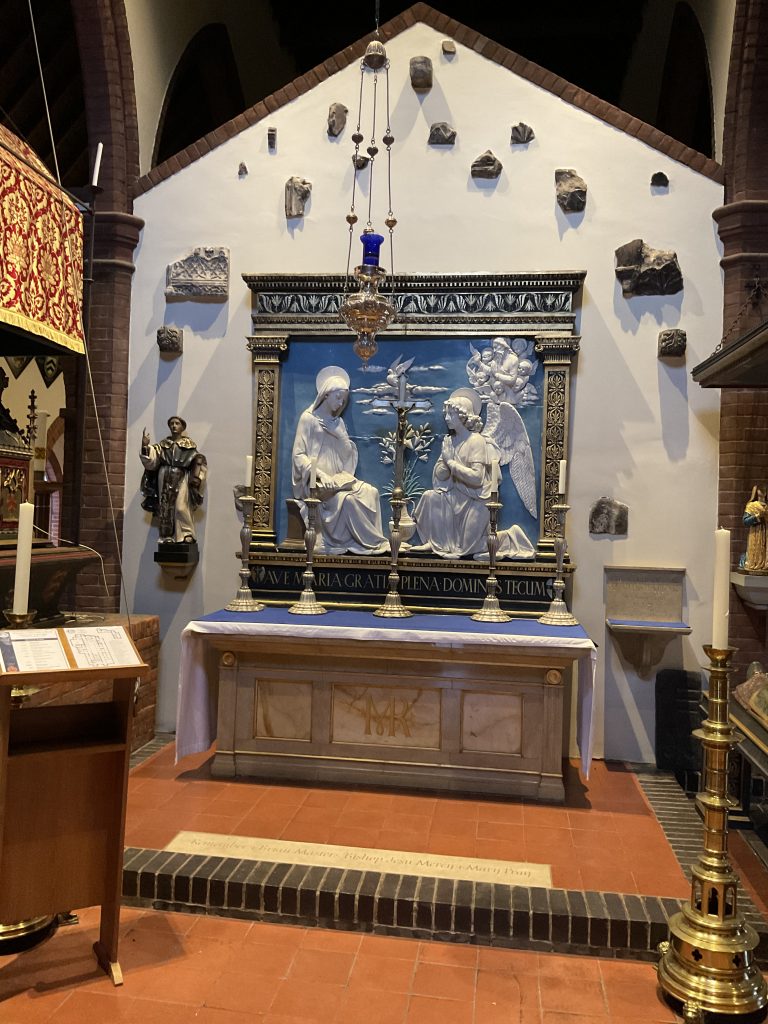Dear brothers and sisters,
In the ‘pilgrim language’ of Walsingham, I have just made my ‘last visit’ of the day to the Holy House, which is at the centre of prayer and devotion in the Anglican Shrine, in which the Orthodox have maintained a chapel and spiritual presence since 1941 (having being involved in Walsingham pilgrim life since 1931), with the chapel being consecrated on Troitsa 1945.

I have previously written of the origin of the Holy House, and will simply quote from a past posting:
“The Mother of God appeared to Richeldis (Rychold), Lady of the Manor of Walsingham in the 11th century, commanding her to build a replica of the original Holy House of Nazareth, later dismantled and rebuilt in Loreto, in Italy, after the Islamic conquest of the Holy Land.
The great shrine and priory, which developed around the chapel of the Holy House was endowed through royal patronage and was renowned throughout Europe, but despite its sanctity and fame it fell victim to the ravages of the reformation and the destruction of the holy places by King Henry VIII and his henchmen.
The 20th century saw the restoration of Anglican religious life around a newly built Holy House and shrine complex.”
The current Holy House, to which the image of Our Lady of Walsingham was translated in 1931, is a very plain structure, echoing the humble simplicity of the Holy House of Loreto, and the mediaeval recreation in the priory a few hundred metres from the current site.
It stands within the Anglican Shrine Church, just inside the ‘west’ door, towards which it is liturgically oriented. The chapel of the Annunciation and shrine of St Vincent of Saragossa are located behind it, between the Holy House and the door and, to its ‘liturgical north’, a Saxon well is accessed by north-south steps (not the original Holy Well, but nevertheless a constant source of healing and blessing from the Mother of God).

The second day of the consecration of the extended church, in 1938, saw the celebration of the Hierarchical Liturgy on the high altar by Archbishop Nestor of Kamchatka, and the memorials of the Walsingham ‘greats’ who welcomed him and the Orthodox pilgrims stand near the Holy House and the west door.
 Above the well, in the north aisle of the church, the effigy of Fr Alfred Hope Paten (1885-1958), a great friend and benefactor of the Orthodox Church in Britain reposes, tomb-like.
Above the well, in the north aisle of the church, the effigy of Fr Alfred Hope Paten (1885-1958), a great friend and benefactor of the Orthodox Church in Britain reposes, tomb-like.
Immediately next to the Holy House, a similar memorial to the sometime Bishop of Acra, Mowbray Stephen O’Rorke (1869-1953) – another friend and supporter of exiled Russian Orthodox Christians is to be found, with a figure of the Lady Richeldis kneeling on the west wall of the Holy House, just above the feet of his effigy. Thanks to Dr David Woolf, for pointing out that Bishop O’Rorke’s mortal remains rest beneath this stately memorial.
Lamps and candles burn in the Holy House day and night, for the intentions of parishes, families, pilgrims and their many intentions, and intercessory prayers are offered there every day of the year. Small paper shields, like zapisky, proclaim the intentions, and give the names of parishes and associations for which lamps burn, both inside and outside the Holy House.
Pilgrims pass through its doors from morning till night, and are struck by the peace and prayerfulness of this very special place in which the pilgrim feels the merciful care and loving solicitude of the Mother of God, ‘Our Lady of Walsingham,’ in its profound and hushed peace, amidst the flames of candles and lamps, gently flickering, blue and red.
Most Holy Mother of God, Our Lady of Walsingham, pray to God for us!
